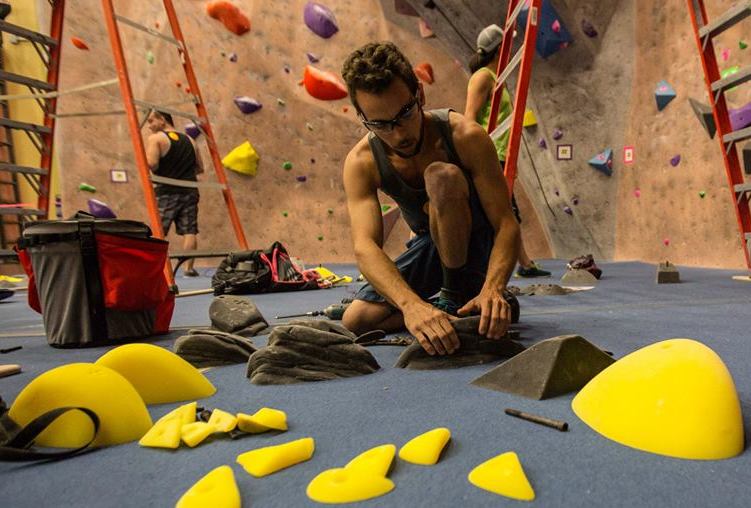Setter Showdown Sweeps Maryland
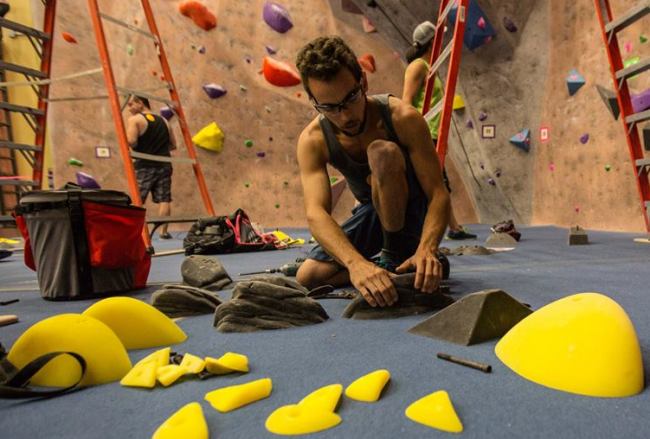
On Sept 5th & 6th, Louie Anderson’s Setter Showdown came to Maryland, bringing 24 of the area’s best setters to Earth Treks’ Rockville facility.
After three rounds of setting, Matt Bosley from Earth Treks – Timonium took the 1st place overall, and Charlie Garcia from Earth Treks – Columbia picked up 3rd place, but it was a late entry from the Pacific Northwest who stole the show. Ken Burkhart from Edgeworks in Tacoma, Washington took 2nd place overall in addition to winning the Most Creative category and the coveted Setters Choice award.
“With such a talented group of setters as my peers, to be chosen by them as the best at the Showdown is a great honor,” Burkhart said after the event. “I also walked away with fresh ideas, techniques, tricks, and some new connections all of which mean just as much to me as any award.”
After winning the overall, Bosley, who is known as much for his climbing ability as his penchant for being humble, said winning was amazing but, “The best part of the Setter Showdown for me was getting to see the Earth Treks community enjoying all of the different climbs,” he said. “There were so many talented setters at the event and I really enjoyed meeting them, sharing stories and climbing with them.”
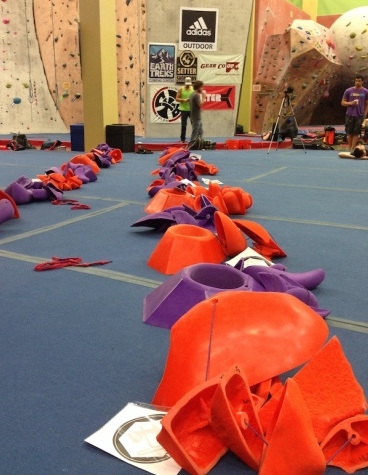
Format
Each round of competition was kicked off by the setters selecting one of the pre-determined sets of holds. They did not have to use all the holds, but they could not trade holds with other setters. Setters were required to set an easy (v1 – v3), medium (v4 – v6) and hard (v7 – v9) boulder problem.
Each round featured climbing holds from a different company.
Round One: Kingdom Climbing.
Hold sets were displayed for the setter to choose but they did not know the difficulty or the wall terrain assigned to each set.
Round Two: Kilter.
Holds were sealed in a black bag so setters did not know which holds they were selecting. The difficulty rating was displayed but the setters did not know the wall terrain assigned to each set.
Round three: Climb-it.
Holds were displayed for the setter to choose with a difficulty rating assigned to it. The setters did not know the wall terrain assigned to each set.
For Bosley the format was fun and challenging, “Fun, because it didn’t necessarily feel like a competition, other than when the guys with clipboards would come around,” he said. “Challenging, because in every round there was an unknown factor … This was a cool setting challenge and I think that it forced many of us to be creative with what we were given and to utilize every feature on the wall.”
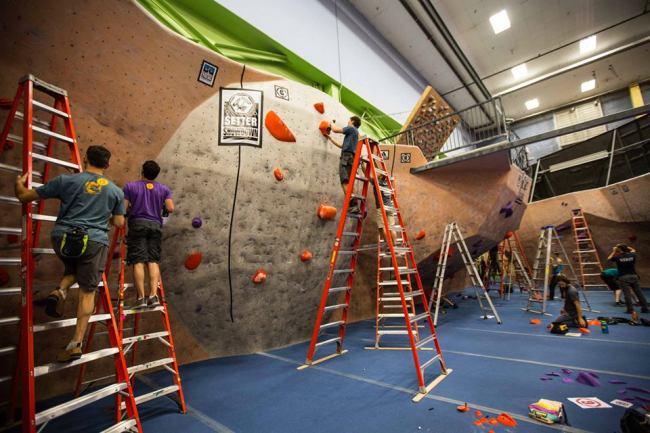
Burkart agreed with this sentiment. “The vibe between the setters was incredible,” he said. “All the setters were excited to be there and even though we were there to compete against one another, it didn’t feel that way at all. We worked together as a team, climbed each other’s routes, and gave helpful feedback.”
The organizer of the Showdown, Louie Anderson, understands the need for the event to be sold as a competition but his real passion is for moving the industry forward. “[Setter] development has always been my underlying goal with the Showdown, and participating setters have commented on how much they appreciate that aspect of it,” Anderson told CBJ. “I could see coupling the competition with various workshops and guest speakers to further that side of things.”
After the successes of the first Showdown (previously called the Kingdom Games) at The Factory bouldering gym near Los Angeles, and this event in Maryland, Anderson says that he has received a tremendous amount of interest from other gyms across the US and Canada.
“I want very much to travel the entire Setter Showdown model to different regions and to be able to work with different groups of setters,” said Anderson.
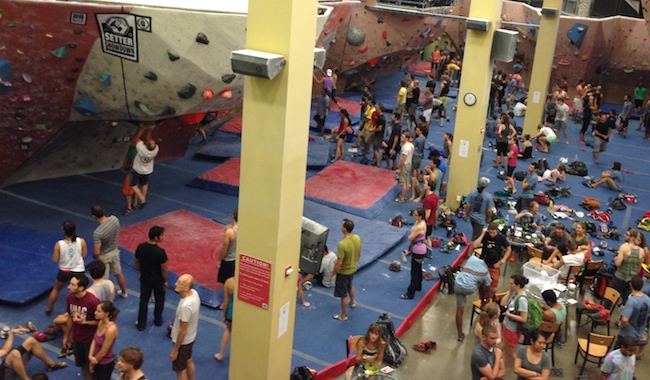
The host gym, Earth Treks, folded the Showdown into a member appreciation BBQ and party. On the second day of the event almost 400 climbers showed up to be “climber judges” and to partake in free food and beer plus live music. After the event ET management told CBJ that they would definitely consider hosting another Setter Showdown.
And if routesetter Ken Burkart’s experience is any example, Anderson and the Showdown could have a successful future ahead of them. “It was easily the most fun I’ve ever had setting,” Burhart said.
Earth Treks Setter Showdown Event Video from Louie Anderson on Vimeo.
Keep Your Climbing Facility Looking New
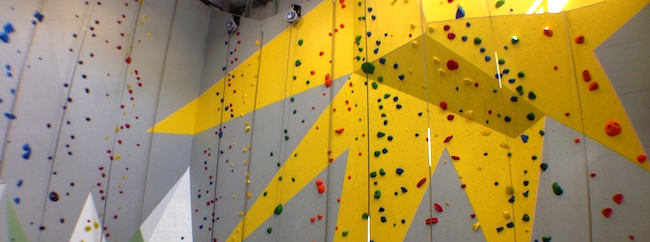
In today’s competitive climbing gym market owners are realizing that they must keep their facility looking as good as it did the day it opened. No longer is it acceptable to have bubbling or torn padding, stinky bathrooms, peeling tape signage, or even worse, cracked walls and falling insulation.
But you don’t have to wait till the competition compels you to clean things up before making improvements to your gym, you can take preventative steps to keep your climbing facility looking like new every day regardless of how long ago operations commenced.
PLAN FOR WEAR AND TEAR
Nothing looks new forever, yet your customers will expect your facility to be great regardless of how old it is. To plan for this, facility operators need to pay special attention to high traffic areas that will show wear and tear regardless of your preventative efforts.
In climbing facilities these areas include edges on floor padding, bouldering landing zones, waiver stations and even the climbing wall itself. Perhaps the biggest offender of wear and tear is in the locker rooms and bathrooms. Make sure to keep an eye on tile around toilets and hand dryers as these can easily collect moisture and mold that can go unnoticed.
After identifying areas of concern, note how long it takes for facility elements to begin to show wear, then document the average lifespan and cost of repair or replacement for future planning.
PROTECT HIGH-IMPACT AREAS
In facilities that see hundreds of users every week or every day, high-traffic and high-impact areas need extra protection. In the weight room, extend your flooring system up the wall 30 inches to protect against damage from free weights. Waiver stations should have keyboard and monitor covers to protect equipment from greasy fingers and chalk dust.
Staff can put a lot of wear and tear on your facility too. Add corner guards to high-traffic areas such as equipment and storage rooms, or anywhere moving carts might be used. The entry way to the setters hold room is a common area that takes a lot of beating from carts and wagons let alone routesetters in a hurry to create their masterpiece. Protect these spaces with sturdy door frames and think about adding ramps for wagons to get up on to padded areas.
SELECT EASY TO CLEAN AND VISUALLY FORGIVING FINISHES
When designing your space trendy material choices may not be your best option, particularly if there is no cleaning history for that new product. In the locker room it’s best to select a dark colored mortar for the tile on your floors, since light-colored mortar gets dirty and stains quickly. In the showers use tiles with a matte-finish that won’t show water spots.
The biggest high use area in a climbing gym is of course the climbing wall itself. Choose a textured paint that is easily washable and won’t show boot rubber. Many wall builders are now offering products that either resist chalk and rubber or are cleaned by simply wiping with a cloth.
DEVELOP AN AGGRESSIVE CLEANING PROGRAM
In climbing gyms a standard custodial cleaning is often not enough to keep the facility looking good and to prevent premature aging of surfaces and equipment. Chalk dust is an ever-present nuance that can make your front desk and retail areas look old and neglected in no time.
It is essential to develop a daily cleaning routine of all user areas and regular maintenance cleaning of harder to reach areas like light fixtures, HVAC ducts and vents, railings and retail fixtures. Budget for quarterly deep cleanings to keep your building looking and smelling like new.
BUDGET FOR REGULAR REFRESHES AND REMODELS
Many fitness facilities use a 7- to 10-year planning and remodeling schedule to ensure their space remains fresh and modern. Climbing gyms should consider this same model for ensuring that capital is allocated for minor refreshing and major remodeling projects of user areas.
This goes for the climbing wall too. The average “life expectancy” for a climbing wall is 10 years. Of course walls last much longer than that but your members psyche for climbing on a 10 year old wall depreciates as well. Instead of tearing the whole thing down, consider replacing sections of the wall that you’re unhappy with. In fact, many modern walls are designed with this purpose in mind. A new climbing texture or surface can make your facility feel new again.
MAINTAIN ADEQUATE ATTIC STOCK
The styles and colors of all the products that went into making your facility look good often change from batch to batch, and undergo more significant revisions over time. This makes matching styles for repairs challenging. Maintain plenty of attic stock to allow well-matched repairs and replacements.
This article was inspired by the article Ten Tips for Keeping Your Rec Center Looking Like New.
Oklahoma To Get New Climbing Gym
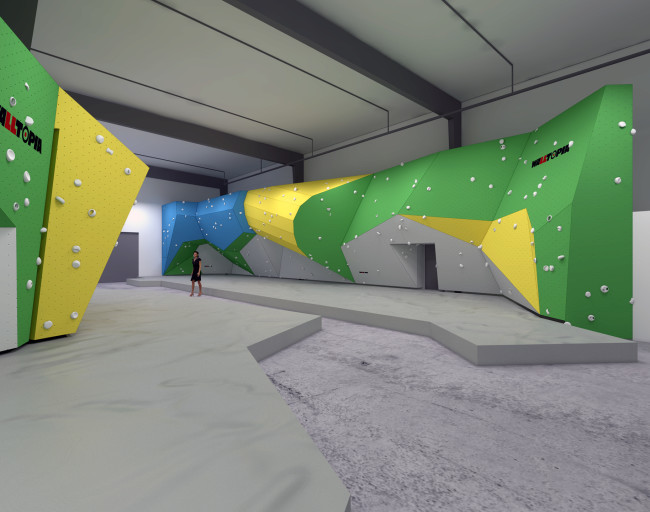
From PRESS RELEASE
Climb UP, a new modern climbing facility in Norman, Oklahoma seeks to build on the growth of climbing in the flatlands and will be the first full-service progressive climbing gym in Oklahoma. The 12,000 sq. ft. space will feature a massive top-out boulder, a 70-foot long by 16-foot tall competition bouldering wall, a variety of top-roping, steep lead climbing terrain, auto-belays, a speed climbing training wall, hangboard area, film and slideshow venue, as well as a dedicated kids boulder, group area, pro shop, and a yoga studio.
Owners Aaron and Lisa Gibson, the husband-wife team, are no strangers to the climbing gym world. They were the operators of Rocktown Climbing Gym in Oklahoma City and spent seven years as the visionaries that brought the silo gym national recognition.
“This new gym has been years in the making,” says Aaron, “When I began climbing 23 years ago I imagined having a climbing gym here in my hometown. We finally have a chance to make that dream a reality.” Aaron calls this new gym a “hybrid.” The makeup is close to 50% rope and 50% bouldering. It’s more weighted towards bouldering than most rope gyms because of
the large student population (Norman is a college town, home to the University of Oklahoma) and ever-growing interest in bouldering but still has quality roped climbing terrain. From a business standpoint they felt the throughput of bouldering would allow more people to engage with climbing more frequently rather than waiting for a roped climb to open up. As such, Climb UP is not purely a bouldering gym, nor is it a standard roped climbing gym, but it can hold it’s own in either category.
“We worked really hard on the concept and layout in order to maximize the functionality of the space while maintaining an openness that encourages people to explore, to observe, and to climb,” says Aaron. While the Gibsons could have gone lower-budget on the walls and built them in-house, they felt that it was value-added to have a top-of-the-line brand, like Walltopia, construct the walls. “There is something to be said for name recognition and professional quality. We felt that Walltopia, with their product had exactly what we were looking for,” says Aaron, “We think it will be well-worth the expense.”
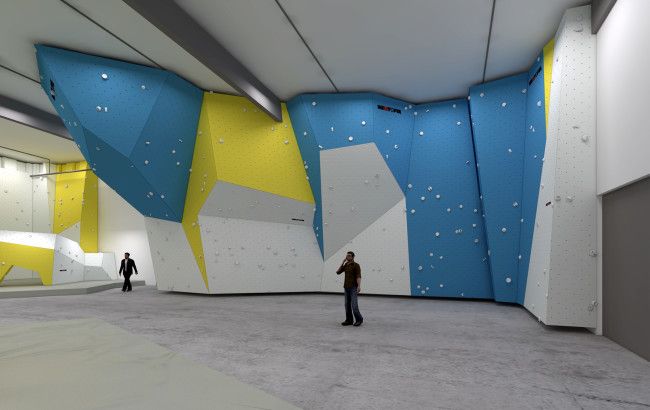
It’s one thing to have great walls but climbers will quickly tell you that it’s the routesetting that makes the gym. To that end, Climb UP will employ experienced setters that are USA Climbing certified. Likewise, all instructors will be CWA certified and all climbing guides will be AMGA certified. The goal is to bring a greater degree of professionalism to the gym and the community.
Climb UP will have a strong focus on programming for young climbers, after school climbing clubs, climbing events, and will be a launch pad for outdoor enthusiasts. “We took into account the large population of kids and young adults when thinking about our programming,” says Lisa.
Climb UP is currently under construction and anticipates an opening date in November of 2014. Find them online at http://climbupgym.com.




